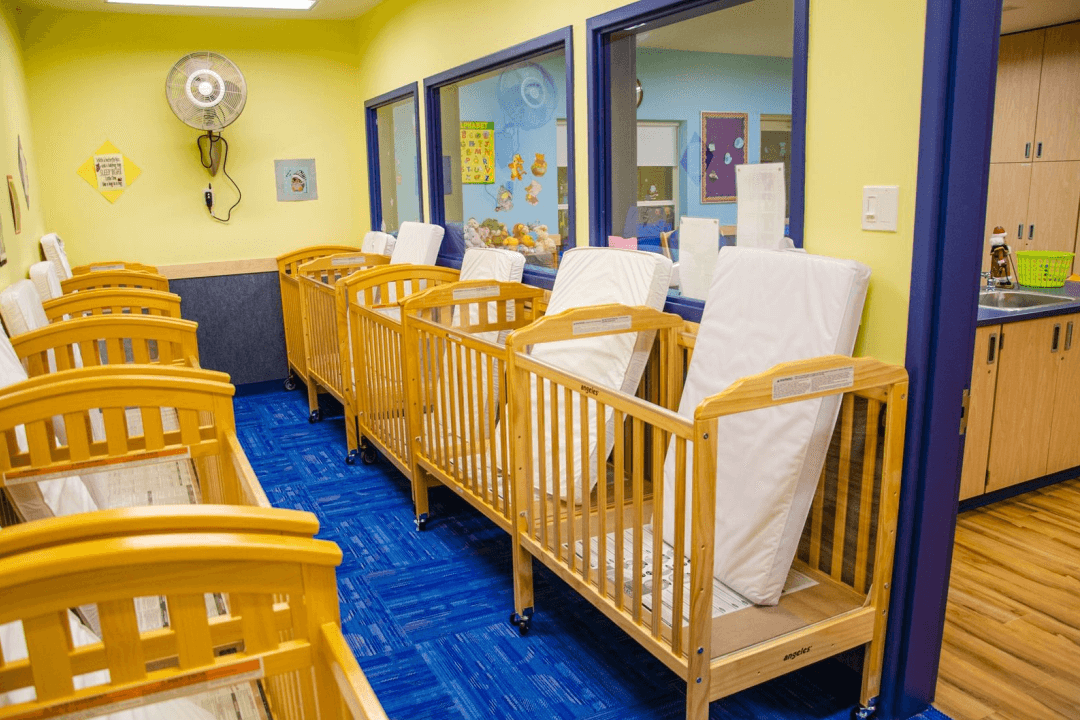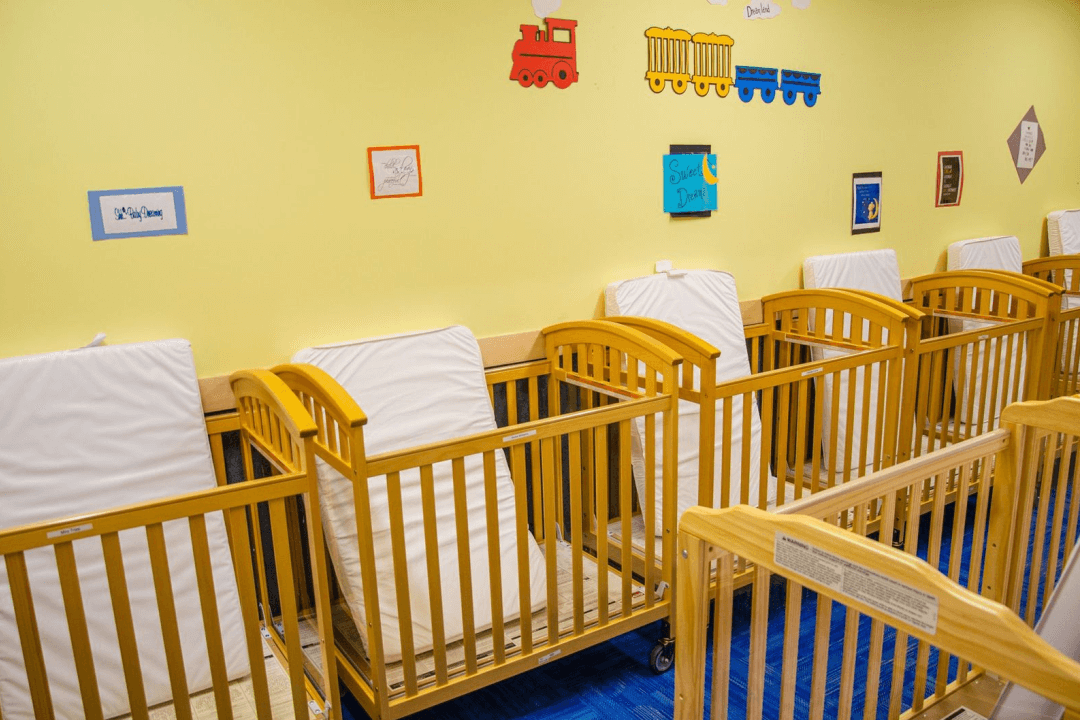Welcome to our guide on how Early Advantage helps babies to sleep at daycare! One of the essential aspects of childcare is ensuring that even the littlest ones get enough rest throughout the day. Establishing good sleep routines not only benefits a child’s well-being and development but also contributes to a smoother and more productive child care experience.
Understanding a baby’s sleep preferences and having open communication with parents is just one of the ways Early Advantage works to ensure a successful sleep routine at daycare.
In this guide, we explore the various strategies and tips that allow us to create an optimal sleep environment for babies and help answer questions parents may have about how to ensure their child will have a peaceful and restful experience at our center.

Sleep plays a vital role in the development of an infant.
Importance of Sleep for Babies’ Development and Well-Being
Quality sleep is paramount for the optimal growth and well-being of babies. During sleep, essential processes such as brain development, memory consolidation, and hormone regulation occur. Adequate sleep also supports emotional resilience and a balanced mood.
For babies who attend our center, establishing consistent sleep routines not only helps ensure their physical health but helps to set the foundation for healthy sleep habits that will benefit them throughout their lives.
Establishing Sleep Routines for Babies
Creating a warm and nurturing sleep environment is at the heart of helping babies transition into a peaceful slumber. By having a consistent sleep routine, babies have a sense of security and predictability, making it easier for little ones to unwind and embrace sleep.
To help create a consistent sleep routine, Early Advantage designed a cozy and age-appropriate sleep space that mimics the comfort of home. Soft lighting, gentle music, or soothing white noise can help create a calming atmosphere. Incorporating pre-sleep rituals like reading a short story or softly singing a lullaby to signal that sleep time is approaching is another way we help babies wind down.
At Early Advantage, we strive to get to know each child. Some babies go to sleep best when they are laid in their crib and can fall asleep on their own. Others do best if our staff rubs the child’s back while they lay in their crib. Still, others enjoy being rocked and falling asleep in an adult’s arms before being transferred to the crib.
Understanding the uniqueness of each child is essential. Some may prefer to fall asleep independently, while others might need a bit more comfort. Our teachers are patient and attuned to each child’s cues, adjusting their approach accordingly.
By creating a nurturing atmosphere, we ensure that infants feel secure, valued, and prepared to begin their adventure into the world of dreams. This is achieved by blending key components: a peaceful setting, calming routines, and personal comforts.

Communication between parents and daycare teachers plays a vital role in establishing an infant’s sleep schedule.
Sleep Preparation Tips for Baby Sleep
Navigating the delicate world of sleeping at daycare involves a blend of understanding, collaboration, and careful planning. We at Early Advantage believe communication with parents is a cornerstone, as their insights into their baby’s sleep habits offer invaluable guidance.
Harmonizing home and daycare sleep habits is a crucial step in the process, one that requires coordination and communication. By working together, parents and our teachers can help synchronize nap schedules, feeding times, and comfort measures to offer a seamless transition between the two environments.
As the day unfolds, weaving quiet and soothing activities into the routine helps babies ease into sleep mode. Gentle stories, soft music, or simple cuddles create a tranquil atmosphere that welcomes rest. Maintaining a balance between structured activities and relaxation time contributes to a smoother transition to naptime.
In a group setting, recognizing each baby is unique is essential. Early Advantage teachers will tailor their approach to cater to individual preferences while also working within the guidelines of our center. For example, at Early Advantage, we only put infants down to sleep in a crib. According to the Sleep Foundation, it is dangerous to have an infant sleep in a device like a swing because sleeping in baby swings has been linked to higher risks of injury, flat spots on heads, blocked airways, accidental suffocation, and death.
At Early Advantage, we also do not provide blankets or stuffed animals for safety reasons until a child is one year of age. Instead, some babies may sleep best with the help of a sleep sack which is a wearable blanket. There are many different sleep sack options available to parents that can work with the infants’ preferences. For example, some children enjoy the starfish type of sleep sack where their hands are inside the sleep sack, while others prefer their hands to be accessible.
We encourage parents to experiment with what type of sleep sack works best for their child and advise them to use caution when using a sleep sack that swaddles the baby once they’ve begun to roll over. Once an infant has begun to roll over, parents should stop using a swaddle sleep sack to help avoid Sudden Unexpected Infant Death Syndrome (SUIDS).

Every child requires a different approach when establishing a consistent sleep routine.
Coping Strategies for Sleep Training So Your Child Will Sleep Well
Guiding babies into peaceful slumber demands a repertoire of strategies that cater to their unique personalities and needs. The journey involves patience, intuition, and a caring touch.
Observing the subtle signs of tiredness is a skill that our teachers work constantly to master. Some obvious cues that indicate it’s time for rest include when an infant begins yawning, rubbing their eyes, or becoming irritable. This is when our teachers (and parents alike) should begin to gently guide babies toward sleep.
For those infants who may struggle with separation anxiety, a gradual approach works wonders. During nap time, our teachers slowly begin distancing themselves while offering reassurance to remain attentive to the child’s emotions. This helps to build trust and confidence. By taking this general approach, our goal is to provide a much-needed sense of security for the infant.
Physical comfort also plays a pivotal role. Gentle rocking, soothing pats, or simply cradling a baby in your arms can make all the difference. Ensuring they feel safe and protected fosters a serene state of mind conducive to sleep.
As for babies who may be fussy, overtired, or anxious, keep in mind these children may require a blend of empathy and creativity. Experimenting with different soothing techniques – be it humming a lullaby, swaying gently, or providing a pacifier – can help find what resonates best with each child.

At Early Advantage, we offer a crib room for sleeping infants.
Creating a Customized Routine for Sleep
Nurturing the sleep needs of babies who attend child care can involve a delicate dance that blends routine with flexibility. This can mean crafting a tailored sleep schedule that respects their developmental stages and preferences to help ensure a harmonious sleep experience between home and daycare.
Keep in mind that each baby’s nap time journey is unique. Early Advantage professionals will tailor routines based on the age and individual requirements of each child. For example, newborn infants might need more frequent naps, while older babies may benefit from more prolonged stretches of sleep. Integrating feeding and diapering schedules into the sleep routine can help not only meet an infant’s needs but also help babies fall asleep faster. Babies are more likely to settle into sleep when their basic needs are met.
Flexibility is also essential. Not every infant adheres to a rigid schedule, and that’s okay. Some might have shorter or longer sleep cycles. Documenting sleep patterns and successes will help both Early Advantage staff and parents alike. By understanding what works and what doesn’t, such as what time each day a child gets tired or is more likely to nap, your child’s care providers will help create a healthy sleep schedule over time.
Talk to your Early Advantage teachers to understand what their recommended approach is to help your child go down for a nap while at the center and what routines they may have in place that you can also implement at home. After all, consistency is vital to maintaining your baby’s sleep schedule.
At Early Advantage our role is to be instrumental in nurturing these healthy sleep habits. We work hand-in-hand with parents to help ensure their baby sleeps better at home and at our center.
Parent Tips for Sleep Habits
As mentioned above, fostering a seamless sleep experience for babies requires a symphony of collaboration between parents and their caregivers. Open communication and shared insights lay the foundation for nurturing healthy sleep routines both at home and in the daycare environment.
Work with your Early Advantage teacher to establish a channel of communication where you can share your baby’s sleep habits, preferences, and any recent changes. Your child’s teacher will also do the same so the exchange of information provides valuable insights that help align home and daycare routines.
At Early Advantage, we encourage parents to share their unique techniques for soothing their baby to sleep. Whether it’s a favorite lullaby or a comforting routine, we can utilize these insights in the daycare environment and help to create a familiar and comforting atmosphere for each baby.

The Early Advantage crib room includes a fan, large windows, and regular checks on sleeping infants.
The Early Advantage Difference
At Early Advantage, we strive to take a unique approach that can help teach babies independent sleep skills and help them sleep at home and daycare, all while offering parents the comfort of knowing their child is in good hands.
To help give parents peace of mind and ensure each child has the necessary care they deserve, Early Advantage offers crib rooms, something most other centers do not offer. This is a quiet, peaceful room where each baby has their own crib. During their nap time, sleeping babies enjoy soft lullabies and a fan that blows air across the room. This is because proper air circulation with a fan has been shown to reduce the risk of SUIDS by up to 72%.
By being able to offer a quiet, separate place for babies to nap on their own schedules, they can enjoy a peaceful, safe sleep without the noise of the other children who are awake. This helps ensure babies are getting adequate rest, which plays a vital role in brain development.
And while our crib rooms are separate from the regular play areas of the classroom, they are still very visible. On top of having many large windows and noise monitoring, our staff conducts 15-minute visual checks whenever a baby is sleeping in the crib room. Child safety and nurturing the development of even the youngest children are just two of the things that play a crucial part in what we do at Early Advantage.
We Are Here For You and Your Child
Early Advantage teachers have patience and a caring touch to create an environment where sleep is a cherished part of the daily routine. We believe in open communication with parents to share insights and collaborate on sleep strategies that create a seamless transition between home and daycare.
By nurturing healthy sleep habits, our teachers contribute to brighter, well-rested futures for the little ones under our care.

